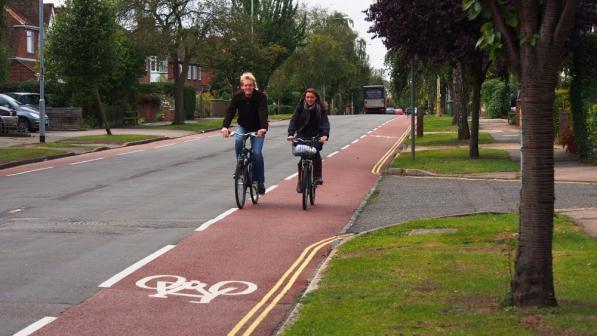Planning and land use policy

Decisions made about if, where and how to develop the land about us, either from scratch or on previously developed sites, affect the way people travel.
Planning policies can either help reduce people’s dependency on cars and enable them to travel more actively and healthily on foot or cycle – or they can do the exact opposite.
For example, focusing development in or near town centres and providing high-quality cycling provision from the start gives local people a viable alternative to driving.
On the other hand, out-of-town housing, retail or business estates – or new schools – served only by intimidating major roads and built with scant thought for active travel are likely to narrow people’s choices and make them rely heavily on cars for everyday journeys.
As such, decisions taken outside a local authority’s transport team can be one of the biggest barriers to getting more people cycling and walking.
Planning is so critical that bad policies and decisions based on them can lead to or exacerbate a diverse range of undesirable results, including:
- Failure to meet strategic goals on sustainable local transport, climate change, air quality, physical activity, obesity and public health
- Developers left largely to their own devices, automatically creating car-dependent estates, especially in areas where cycling levels are (or seem) low
- Sprawling rather than compact development, leading to longer journeys to the shops, health-care, offices, schools and other key destinations and services
- Unsafe road conditions for cycling and walking caused by extra motor traffic, ill-thought junctions, no pavements, loss of convenient crossing points (e.g. by removing or moving a crossing, or making a new or wider road uncrossable)
- No, very little and/or insecure cycle parking and storage (e.g. in town or village centres for the public, for commuters at their workplace, or for people living in flats)
- Lorry movements during construction that put vulnerable road users at risk.

Background
The planning system in the UK is ‘plan-led’, which means that permission for the development of land (construction) has to align with national and local plans.
Each UK nation is covered by various planning laws, and they review, renew and reform their policy/framework as and when necessary.
Local planning authorities also produce their own distinctive planning policy and associated documents, which are expected to be consistent with the principles set by the relevant national government.
National planning policies and active travel
Cycling UK believes that national policies should clearly recognise that active travel contributes positively to all three of the traditional priorities of planning in the UK: the economy, society and the environment.
Cycling and walking are, after all, a cost-effective investment, good for health and wellbeing and help tackle pollution, greenhouse gas emissions, noise and the blight of too much motor traffic.
Policies should also state unambiguously that over-dependency on cars causes environmental and other harm, and enable and encourage local authorities to refuse development on the grounds of such harm.
Planning policy is already being influenced by the threat of climate change, but this tends to be in a defensive way – e.g. on flood risk and coastal erosion. This is not enough – it also needs to be unequivocally proactive about the need to boost the take-up of low-carbon transport.
As mentioned, policy differs from nation to nation and, in Cycling UK’s view, some is considerably more conducive to sustainable transport than others (e.g. in Wales).
For more on Cycling UK’s partnership work on reforms that will ensure that the planning system is fit for the climate, nature and people, see the Better Planning Coalition.
Best practice for local authorities
While local authorities must have regard to the relevant national planning framework, their chances of resisting, modifying or enhancing development proposals to avoid harm and maximise the benefits of active travel are much stronger if their own distinctive planning policies explicitly support the following:
Assessments of carbon, road safety and accessibility by cycle
Before granting planning permission, local authorities should rigorously assess development proposals for their potential impact on:
- Carbon emissions from traffic, with the results made public to help inform residents’ responses to planning applications. In fact, assessing traffic emissions from development over the whole area and aggregating these data nationally would help governments assess their planning policies against climate change targets.
- Road safety for vulnerable road users – this is no small consideration: a successful campaign objecting to HGV operations in Pevensey is a case in point.
- Accessibility by cycle (covered variously below).
20-minute neighbourhoods
The 20-minute neighbourhood principle means planning towns and cities so that key facilities – such as food shops, schools, public transport and health-care facilities – can be reached within a short walk or cycle ride of people’s homes. The location of new housing and other developments also needs to reflect this principle.
Parking standards for maximum car parking and minimum cycle parking
Parking standards, setting strict limits on car parking spaces and the minimum for cycles are an important motor traffic demand management tool. These are often covered in supplementary planning documents (SPDs) or published guidance (see Cambridge City Council’s cycle parking guide for new residential developments, for example).
Travel plans
Travel plans for new developments are a collection of practical measures to reduce motor traffic and promote alternatives. They tend to feature routes, maps, cycle storage etc., and many local planning authorities insist on them and offer guidance.
If adopted as part of a wider planning agreement with a developer, travel plans may help settle community concerns about extra motor traffic in the neighbourhood but they must not be tokenistic – i.e. merely the developer’s bid to make planning permission more likely (and only involve, say, delivering a bus timetable to every new resident).
A commitment to monitor and evaluate a travel plan is equally important. Unfortunately, though, some local authorities don’t invest in this and/or lack the will to make sure that a developer honours their obligations.
Developer contributions
Planning permission usually increases a site’s value, so a levy or tax may be made to divert some of this ‘planning gain’ for public benefit.
Developers’ contributions, which are covered by various legislation, refer mainly to the Community Infrastructure Levy (CIL, England), Section 106 obligations (England & Wales), or Section 75 (Scotland). (At the time of writing, moves to replace s106 and CIL in England with an ‘Infrastructure Levy’ are under way).
Contributions can and, in Cycling UK’s view, should be put towards sustainable transport (e.g. paying for high-quality cycle routes/links etc.), and we urge all local authorities to formalise the need for them in their planning documents.
Complying with national guidance on cycling infrastructure
See:
- Cycle Infrastructure Design, LTN1/20, (DfT, 2020)
- Active Travel Act Guidance, (Welsh Government, 2021)
- Cycling by Design, (Transport Scotland, 2021 update)
Active Travel England, the Government’s executive agency responsible for making walking, wheeling and cycling the preferred choice for everyone to get around, is to be a statutory consultee in the planning system, and will review active travel provision in major planning applications.
Walking/cycle-friendly town centres, area-wide ‘filtered permeability’ and a high design standard for the public realm
Secure cycle parking and restricting the through movement by motor vehicles, for instance, not only makes active travel more appealing, but also increases a town centre/high street’s attraction and vitality (and, as we know, many are struggling at the moment).
Similarly, an aesthetic and welcoming public environment, with seating, al-fresco dining areas, green spaces, artwork etc, that caters for people rather than cars is more likely to be a cycle-friendly one.
Cycles, though, shouldn’t be subject to unnecessary bans or expected to negotiate good-looking but cycle-unfriendly infrastructure (e.g. slippery cobbles).
Houten in the Netherlands is a good example of a new town that catered well for cycling from the start, and still does.
Rural cycling
Cycling, of course, is not simply an urban pursuit. Rural developments need to be accessible on foot and by cycle too (or through active travel combined with public transport).
Off-road cycling
Also, many people of all ages do or would like to cycle on motor traffic-free routes, for fun, exercise, commuting, tourism, family days out etc. For planning, this means:
- safeguarding routes such as disused railway lines, canal towpaths etc – these can act as long-distance, commercially successful leisure routes, but also form strategically important links for utility cycling
- not interfering with useful, or potentially useful, rights of way (e.g. by developing over a bridleway and severing or extinguishing it). Instead, development should look to enhance the local off-road network for the community’s use
- looking favourably on, for instance, sympathetically designed centres for MTB or BMX activities
- insisting that leisure and tourism developments provide for active travel.
Public health
The lay-out of villages, towns and cities influences how healthy residents’ usual mode of transport is likely to be. Indeed, health professionals’ interest in enabling active travel via the built environment has escalated in recent years.
Close collaboration with colleagues in transport, health and education
As the list above suggests, success for active travel via planning means collaborating closely with other departments, especially in transport, health and education.
Meaningful community engagement
Friction between local democracy and national planning objectives is almost inevitable, and one of the best ways of tackling it is through the process of timely, meaningful and transparent engagement with the local community.
This goes for statutory consultation on overarching frameworks as well as for individual planning applications and, depending on the scale, should involve local residents, NGO stakeholders and local interest groups (e.g. cycle campaigns).
While developers may complain if consultation is taking a long time, it is unreasonable to expedite the process at the expense of giving the community time to prepare a case, air and resolve concerns. Objectors are, after all, likely to be unpaid lay people who either have to acquaint themselves with a legalistic system, or call in expert help with little if any financial backing.
If you want cycling to flourish in your neighbourhood, see our advice on how to make the planning system work.
See also:
And, to support you in speaking up for cycling, do consider joining our Cycle Advocacy Network
A note on a ‘Third party right of appeal’
At the moment, a developer (1st party) has the right to appeal against a planning decision made by a planning authority (2nd party), but communities or others (i.e. 3rd parties) do not, despite the impact that some approved schemes will have on them.
There are concerns that 3rd party appeals might lead to developments being blocked without good reason, but these could be allayed by permitting such appeals only in certain, limited circumstances, e.g. if the scheme is not in line with the council’s overarching plan, or where it has a financial or other interest.
Further reading
Cycling UK blogs
- We need pedal-powered planning now
- Making the planning system work for cycle campaigners
- Invest in cycling but fix the planning system too

